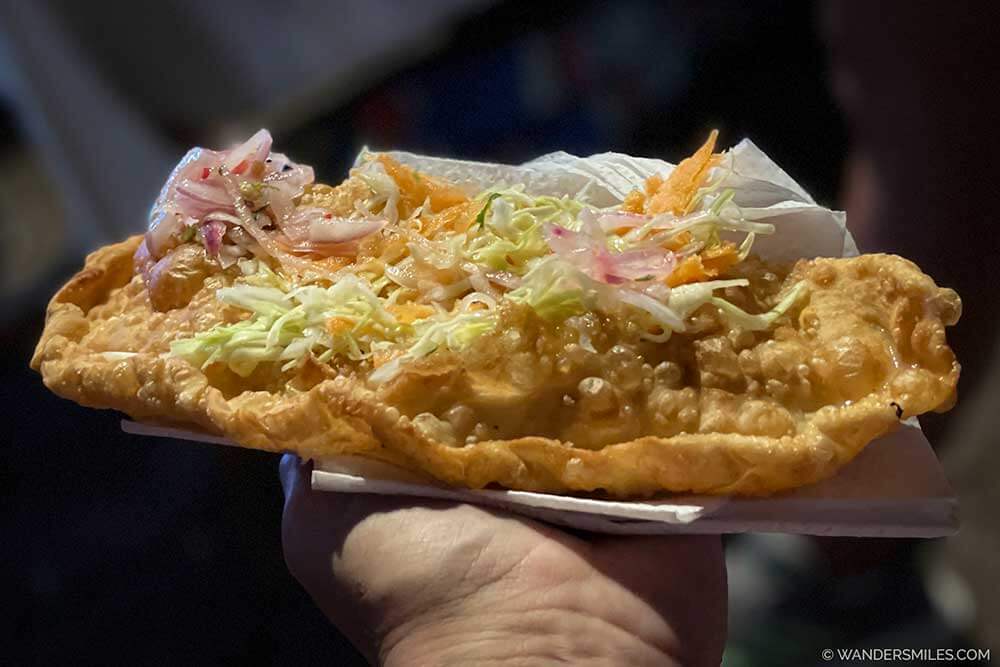17 Traditional Ecuadorian Foods (& drinks) to try on your travels
9 min read
Table of Contents
Welcome to a tantalizing journey through the vibrant and diverse world of Ecuadorian cuisine!
Having spent three months travelling through Ecuador from the lush Amazon rainforest, and Galapagos Islands to the high Andean peaks, I tried as many traditional Ecuadorian foods as I could.
Let’s explore the rich tapestry of flavours, ingredients, and traditions that define typical Ecuadorian foods. From the zesty delights of ceviche and encebollado to the comforting embrace of locro de papa and hornado, each dish tells a story of Ecuador’s culture and history.
Join me as we uncover the typical Ecuadorian foods you should try on your next trip from soups, main dishes and desserts. Buen provecho!
Traditional Ecuadorian Soups (sopas)
Encebollado
Encebollado is a quintessential Ecuadorian seafood soup renowned for its bold and invigorating flavours. At its heart is fresh fish (pescado), which is simmered to perfection in a zesty broth infused with onions, tomatoes, and coriander.
What makes encebollado truly special is the generous addition of pickled red onions, adding a tangy crunch that cuts through the richness of the dish. Often served with yuca (cassava) and garnished with lime, this hearty soup is known for its rejuvenating properties, often dubbed “Ecuador’s hangover cure.” Encebollado is a testament to Ecuador’s coastal culinary heritage, offering a vibrant, soul-soothing taste of the sea.

Locro de Papa
Locro de Papa is a beloved Ecuadorian potato soup that embodies the heartiness and tradition of Andean cuisine. I loved this soup on my quest to try as many traditional Ecuadorian foods as I could!
This creamy and comforting dish is a culinary cornerstone, featuring chunks of potatoes simmered in a savoury broth flavoured with onions, garlic, cumin and achiote. Locro de Papa is often enriched with cheese, avocado, and crispy fried pork or chorizo, lending it a delightful complexity of textures and flavours.
Served hot and garnished with fresh herbs like coriander, it’s a comforting embrace on chilly Andean evenings and a testament to Ecuador’s deep-rooted connection to the potato, a staple crop native to the region.

Traditional Ecuadorian Foods
Chaulafan
Chaulafan is a delightful Ecuadorian fried rice dish that fuses Chinese and Ecuadorian culinary influences into a harmonious medley of flavours. This fusion dish showcases the diversity of Ecuador’s cuisine.
Chaulafan starts with stir-fried rice, often cooked with a variety of ingredients like vegetables, eggs, shrimp, chicken, or pork, all seasoned with soy sauce and spices. It’s a testament to Ecuador’s cultural melting pot, reflecting the influence of Chinese immigrants who brought their culinary traditions to the region.
Chaulafan’s balance of savoury and aromatic flavours, combined with the Ecuadorian flair for fresh ingredients, makes it a favourite comfort food, offering a unique and mouth-watering taste of Ecuador’s gastronomic heritage.

Llapingacho
Llapingacho is a beloved Ecuadorian dish that embodies the country’s rich culinary heritage. These tasty potato patties are a staple in Ecuadorian cuisine, celebrated for their robust flavours and cultural significance.
Llapingacho is made by mashing potatoes and mixing them with cheese, onions, and a hint of achiote for a vibrant colour. The mixture is then shaped into thick, golden-brown disks and fried until crispy. They are usually fried in animal fat so vegetarians and vegans would need to check this!
Typically served with a peanut sauce, a fried egg, chorizo, avocado, and a side of curtido (pickled onions and tomatoes), llapingacho blends creamy, crunchy, and tangy elements into a satisfying culinary experience that’s quintessentially Ecuadorian.

Hornado
Hornado is a delectable Ecuadorian culinary treasure, celebrated for its succulent roast pork. This dish begins with a whole pig, marinated in an aromatic mix of spices, typically including garlic, cumin, achiote, and bitter orange juice. The pig is slow-roasted until the skin turns irresistibly crispy, while the meat inside becomes tender and infused with the marinade’s rich essence.
Hornado is often served with hominy corn, mote, llapingacho (potato patties), fresh avocado slices, and a zesty tomato-onion curtido. It’s a festive and communal dish, often enjoyed at gatherings and special occasions, reflecting Ecuador’s deep appreciation for hearty, communal meals. Hornado is served in most mercados, just look out for the pig’s head!

Seco de Chivo
Seco de Chivo is a savoury Ecuadorian stew featuring goat meat slow-cooked to tender perfection. Infused with a flavourful blend of spices, tomatoes, and beer or chicha, this hearty dish captures the essence of Ecuadorian comfort food.
Seco de Chivo is commonly served with rice, and fried plantain. If you love this Ecuadorian stew dish, you can find it on the breakfast menu as well alongside fried eggs and tigrillo (mashed green plantains, egg, and cheese). It was one of my all-time best Ecuador favourite foods.

Ceviche
Ceviche is a cherished culinary gem in Ecuador. This refreshing dish revolves around fresh seafood, typically shrimp or white fish, marinated in a citrusy blend of lime or bitter orange juice. The acid from the citrus “cooks” the seafood, transforming it into tender, flavourful morsels. Ecuadorian ceviche often includes red onions, tomatoes, coriander, and sometimes peppers, adding a vibrant medley of textures and tastes.
Served chilled and garnished with plantain chips or popcorn, it’s a zesty and invigorating delight, embodying the coastal spirit and love for seafood that runs deep in Ecuador’s culinary heritage.

Cuy Asado
Cuy Asado is a traditional Ecuadorian dish that features roasted guinea pig. Considered a delicacy, the cuy is marinated in spices, herbs, and often beer or chicha, then slow-roasted to achieve a crispy exterior and succulent interior.
I have to admit that I wasn’t brave enough to try the guinea pig after seeing them whole on skewers with legs akimbo showing their two front teeth!
Bolón
Bolón is a beloved Ecuadorian dish, celebrated for its unique blend of textures and flavours. This delightful concoction revolves around green plantains, which are mashed and mixed with cheese, sometimes chicharrón (crispy fried pork), and various spices. The mixture is shaped into large, round balls and then fried until they achieve a crispy, golden exterior, while maintaining a tender, starchy core.
Bolón is typically served as a side dish, often accompanied by avocado slices, pickled onions, or aji (spicy pepper sauce). Whilst they don’t look very appetising, this classic traditional Ecuadorian food has a satisfying taste and comforting simplicity.

Chuleta
Chuleta is a mouthwatering Ecuadorian dish that spotlights succulent fried pork chops. These thick, bone-in cuts of pork are marinated in a flavorful blend of spices, often featuring garlic, cumin, achiote, and bitter orange juice. The marinade infuses the meat with a delicious blend of savoury and tangy flavours. After marinating, the chuletas are fried to perfection, resulting in crispy, golden exteriors and tender, juicy interiors.
Ecuadorian chuleta is frequently served with accompaniments like rice, yuca, avocado, and a zesty tomato-onion curtido. This dish showcases the country’s love for hearty, and satisfying meat preparations, reflecting its culinary diversity and passion for bold flavours.
Empanada
Ecuadorian empanadas are delightful hand-held pastries that encapsulate a world of flavours. These savoury or sweet turnovers consist of a flaky, golden crust, often made from corn or wheat, and are generously stuffed with a variety of fillings. Common options include cheese, meat, plantains, or a blend of all these ingredients.
Each region in Ecuador offers its unique twist on empanadas, featuring diverse seasonings and accompaniments. Served as snacks or appetizers, Ecuadorian empanadas are a beloved street food, showcasing the country’s culinary creativity and its passion for handheld, portable delights.
My favourite empanada discovery was a street seller in Puerto Ayora, Santa Cruz Galapagos. The empanada stands were surrounded by locals which is always a top sign. They are filled, wrapped and fried whilst you wait and they just melt in your mouth. One of the traditional Ecuadorian foods you must try!

Typical Ecuadorian Desserts
Maduro con Queso
Maduro con queso is a delightful Ecuadorian dish that combines the sweetness of ripe plantains with the creamy richness of cheese.
Ripe plantains are sliced and fried until they turn golden and caramelized, creating a crispy exterior that contrasts beautifully with their soft, sweet interior, and stuffed with either grated or sliced cheese.
The savoury-sweet combination is a staple in Ecuadorian cuisine, whether served as a snack, side dish, or even as a dessert. I found it hard to walk past a street food seller with plantain on the grill without walking off with a Maduro con queso in my hand!

Quimbolitos
Quimbolitos are a delightful Ecuadorian dessert that encapsulates the essence of traditional Andean cuisine.
These steamed, sweet treats are made from a mixture of corn masa, sugar, butter, and spices, typically wrapped in banana leaves or corn husks. The resulting confections have a soft, slightly dense texture, akin to a moist cake, infused with anise and cinnamon. Quimbolitos often feature a surprise in the centre, like raisins or a slice of cheese, adding depth to the taste experience.
These small, aromatic packages are a beloved part of Ecuador’s culinary heritage, enjoyed during celebrations and as a cherished symbol of Ecuadorian culture. I heard a street seller in Guamaote Thursday market shouting Quimbolitos and I was so happy I was lured in, they were a light fluffy dessert after my lunch.

Espumilla
You will see street sellers walking around plazas and main streets with what looks like ice cream but don’t be fooled. Espumilla is a beloved Ecuadorian dessert that combines the richness of meringue with tropical fruit flavours.
Made with egg whites, sugar, and fruit puree, it’s whipped to a fluffy, airy consistency. Espumilla is typically served in a cone offering a delightful blend of sweetness and fruity zest, a popular treat at local markets and celebrations.

Helado con queso
Helado con queso is a distinctive Ecuadorian ice cream dessert that blends the sweetness of ice cream with the savoury richness of the cheese. This unique dessert delicacy marries creamy textures, creating a delightful fusion of flavours. This frozen treat sounds wrong but was a surprisingly tasty experience.

Typical Ecuadorian Drinks
Canelazo
Canelazo is a warm and comforting Ecuadorian drink, especially popular in the Andean regions, known for its ability to chase away the chill of high-altitude nights. This aromatic brew combines aguardiente (a local sugar cane spirit), sugar, and water, infused with spices like cinnamon, cloves, and naranjilla fruit.
It’s a delightful balance of sweet and spiced flavours, offering a soothing, heated respite on cold evenings. Often garnished with a cinnamon stick, Canelazo not only warms the body but also evokes a sense of Ecuadorian tradition and conviviality, making it a cherished beverage for both locals and visitors.

Chicha
Chicha, a traditional Ecuadorian drink, has deep cultural roots with indigenous people dating back to pre-Inca times. Chicha is crafted from either fermented maize, yuka, quinoa or rice depending on the region or province. I was shown how to make yuka chicha in the Amazon which was mushed up and left to ferment, resulting in a mildly alcoholic and slightly tangy beverage.
Chicha is a symbol of indigenous Ecuadorian heritage, often consumed during festive gatherings and celebrations. It embodies the country’s rich history and traditions, reflecting the importance of the staple foods in the region. Chicha is not only a drink but also a testament to Ecuador’s cultural diversity and the preservation of age-old customs.

Ecuadorian Food Experiences
Wherever you go in Ecuador, there will be a food experience that suits your preferences. So whether you want to explore the street food, traditional Ecuadorian foods, or the cacao scene, you will a tour for you!
PIN TO TRY TRADITIONAL ECUADORIAN FOODS ON YOUR NEXT TRIP
Disclosure: This post contains affiliate links, which means I may receive a small commission if you click a link and purchase something that I’ve recommended. It comes at no cost to you. Thank you for your support.






